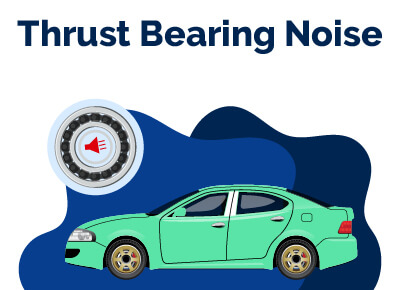Thrust Bearing Noise (Major Causes and Fixes)
July 25, 2023


Chris is Head of Content for FindTheBestCarPrice and is based out of Philadelphia, PA. As a seasoned automotive industry analyst and car enthusiast, he ensures the highest level of quality across all our content and curates our picks for the best deals each month.
Chris studied information systems and marketing at Drexel University and writes about a wide range of topics ranging from car buying tips to troubleshooting common mechanical issues.
When he’s not thinking about cars, he likes to stay in with his dog and make an “attempt” to finish a crossword puzzle (he’s not quite at the Saturday/Sunday level…yet). As a former cheesemonger, Chris still has a “sharp” passion for all things cheese, and his fridge is always loaded with it!
Chris also has a passion for things that go fast, and drones are no exception. He spends some of his time writing for Dronesourced.
If you've noticed a strange noise from your car's engine, it could be a sign of a thrust bearing problem. Thrust bearings are a critical component of your car's engine, supporting the crankshaft and ensuring it rotates smoothly.
A noisy thrust bearing can be caused by several factors, ranging from a lack of lubrication to wear and tear over time. While diagnosing the problem can be daunting without professional help, you can take a few steps to troubleshoot the issue on your own.
Let’s explore the common causes of thrust bearing noise in cars. We will also provide tips on how to diagnose the issue and what steps you can take to fix it.
Let’s get started!
Table of Contents
What Is Clutch Thrust Bearing?
The clutch thrust bearing, the release bearing, or the throw-out bearing is a small yet crucial component of your vehicle's clutch mechanism.
Positioned on the housing of the clutch assembly, it glides along a hollow shaft. The clutch fork is affixed to the clutch bearing, which imparts motion to the bearing through hydraulic or cable pressure.
The bearing moves inward, exerting pressure on the spring of the pressure plate only when the clutch pedal is depressed.
This action disengages the clutch disc from the flywheel, effectively interrupting power transmission to the transmission. This facilitates seamless gear engagement and shifting, ensuring precise and secure operation of the clutch system.
Causes of Clutch Thrust Bearing Noises
In most vehicles, the clutch thrust bearing does not require routine maintenance, as it is designed to endure the vehicle's lifespan.
However, prolonged usage and exposure to environmental factors, such as heat and cooling cycles, can lead to wear and tear on the clutch thrust bearing, particularly in older vehicles.
This is often exacerbated by the ingress of clutch lining dust into the bearing due to compromised seals.
Another common cause of clutch thrust/release bearing damage is inadequate cable adjustment over time, resulting in constant contact between the bearing and the clutch pressure plate.
This persistent contact causes continuous spinning of the bearing, significantly reducing its operational lifespan.
Improper clutch utilization can also contribute to premature wear of clutch components, including the thrust bearing.
Examples of improper clutch usage encompass initiating the vehicle in gear other than first, downshifting multiple gears simultaneously (e.g., 4th to 1st), and skipping gears during gear shifting (e.g., 1st to 3rd).
How To Know Your Clutch Thrust Bearing Is Bad
The following are the most common symptoms of a failed clutch thrust bearing:
1. When There Are Vibrations in the Clutch Pedal
As you depress the clutch pedal, a seamless downward motion is expected. However, if you begin to experience palpable vibrations emanating from the pedal, it is probable that your clutch release bearing is malfunctioning or has entirely ceased to function.
To be more precise, these vibrations are indicative of misalignment between the throw-out bearing and the pressure plate.
As this misalignment occurs, your foot will perceive pulsations or tremors through the pedal, akin to the sensation felt in a brake pedal when the disc brakes or brake pads exhibit uneven wear patterns.
2. When the Clutch Is Stiff
Like other elements in the transmission system, the clutch release bearing is engineered with specialized lubrication properties to ensure its seamless operation over an extended duration.
However, regrettably, these lubrication properties gradually diminish as the bearing undergoes wear and tear.
Depressing the clutch pedal becomes progressively more arduous as the bearing deteriorates further.
Eventually, it may reach a critical point where complete clutch disengagement becomes unattainable, rendering the vehicle inoperable. This is due to the inability to shift gears, impeding further driving.
3. When You Hear Strange Noises Whenever You Depress the Clutch Pedal
The telltale sign of a faulty throw-out bearing is the emergence of various auditory cues upon depressing the clutch pedal.
Ordinarily, the rollers within the bearing are crafted meticulously and positioned close to one another.
However, if the rollers develop excessive clearance, many noises may ensue. These can manifest as rattling, grinding, squealing, growling, or whirling sounds emanating from the transmission area.
This can be attributed to the gradual wear and tear of the bearing's rollers, resulting in the loss of minute amounts of material.
Notably, the noise is most pronounced when the clutch pedal is fully depressed and tends to diminish or vanish altogether when the pedal is released.
4. When You Have Trouble Shifting Gears
Effortless and seamless gear shifts devoid of resistance indicate a well-functioning transmission system.
However, if you begin to encounter challenges while shifting gears or experience gear grinding, it is plausible that the throw-out bearing has deteriorated.
The root of the problem lies in the incomplete engagement of the clutch, although this symptom typically surfaces after other warning signs.
Unusual noises emanating from the transmission area are often the initial indication of a faulty throw-out bearing.
Should this issue be left unaddressed, it is likely to escalate, resulting in further complications such as gear shifting difficulties or clutch slipping. Timely intervention is essential to prevent the worsening of the problem.
How To Prevent Premature Clutch Thrust Bearing Wear
While the incidence of clutch thrust bearing failure may vary across different vehicle makes and models, it remains an inevitable consequence of wear and tear over time.
Proactive measures can be taken to safeguard against the detrimental consequences of a malfunctioning throw-out bearing.
Here are some recommendations to mitigate the risk of encountering severe effects associated with a faulty thrust bearing:
1. Carry Out Routine Maintenance Procedures
Adhering to the prescribed maintenance schedule as outlined by the vehicle manufacturer is the optimal approach to ensure comprehensive servicing of your transmission and clutch, thereby enhancing the longevity of your vehicle.
When replacing the clutch as part of routine maintenance, it is also imperative to include replacing the throw-out bearing with genuine OEM parts.
It is crucial to entrust this task to skilled automotive technicians who will diligently perform a thorough job to ensure optimal performance and durability of the clutch system.
2. Improve Your Driving Habits
Modifying your clutch engagement technique is a practical approach to mitigate wear on the thrust bearing.
The optimal practice involves minimizing the duration of clutch engagement, such as shifting to neutral when coming to a stop, rather than keeping the clutch pedal fully depressed.
By avoiding prolonged clutch engagement, you can significantly extend the lifespan of the throw-out bearing and enhance its durability.
3. Inspect Your Car Periodically
The early detection of thrust bearing failure can be achieved through regular and meticulous inspections by your automotive technician.
Increased frequency of inspections allows for a more comprehensive assessment of your vehicle's aging process, enabling them to proactively identify potential clutch or transmission issues, including throw-out bearing failure, before they escalate into more severe and damaging effects.
By staying vigilant and proactive in monitoring the condition of your thrust bearing, you can effectively mitigate the risks of unexpected failures and prolong the overall longevity of your vehicle.
Thrust Bearing Replacement Cost
Due to its simple nature, the throw-out bearing itself is relatively inexpensive. However, the challenge lies in the labor-intensive process of accessing it, as it necessitates the removal of the entire transmission.
Consequently, replacing the clutch (and sometimes the flywheel) is commonly recommended while undertaking this task.
A throw-out bearing typically costs from $30 to $100. At the same time, the price of a new clutch can vary significantly depending on the vehicle, usually within the range of $300 to $800. Additionally, a new flywheel, if required, may cost an additional $50 to $200.
As mentioned previously, labor costs for throw-out bearing replacement are the primary expense.
With an estimated 4 to 6 hours of labor required to replace the throw-out bearing and clutch, at an average labor rate of $85 per hour, the labor cost alone would amount to approximately $360 to $550.
Altogether, the total cost for replacing just the throw-out bearing would range from $400 to $650.
However, considering the common practice of replacing the clutch concurrently, the total replacement cost would likely amount to a higher range of $700 to $1500.
Best Car Deals by Category
Frequently Asked Questions
What are the typical thrust bearing noise symptoms?
Common thrust-bearing noise symptoms include rattling, grinding, squealing, growling, or whirling sounds when depressing the clutch pedal, especially with the clutch pedal fully depressed. These noises may originate from the transmission area and disappear when the foot is lifted off the clutch pedal.
How can I detect early signs of thrust-bearing failure?
Regular ongoing inspections by a qualified automotive technician can help detect early signs of thrust bearing failure. Frequent inspections allow the technician to monitor the vehicle's aging process and anticipate potential clutch or transmission issues, including thrust bearing failure, before they cause further damage.
How much does it cost to replace a thrust bearing?
The cost of replacing a thrust bearing can vary depending on factors such as the make and model of the vehicle, labor rates in your area, and whether other components like the clutch or flywheel also need replacement. As a rough estimate, the total cost of replacing just the thrust bearing can range from $370 to $610, while replacing the clutch as well may increase the total cost from $670 to $1410.
Can I replace a thrust bearing myself?
Replacing a thrust bearing typically requires specialized knowledge, tools, and experience with automotive repairs. It is recommended to seek the services of a qualified automotive technician with expertise in clutch and transmission systems to ensure proper installation and avoid further damage to the vehicle.
How can I prolong thrust bearing wear?
Engaging the clutch pedal for the shortest possible duration, such as putting the vehicle in neutral when coming to a stop instead of keeping the foot pressed down on the clutch, can help prolong thrust bearing wear. Additionally, following the manufacturer's recommended routine maintenance schedule, including clutch replacement and using OEM parts, can also prolong thrust bearing wear.
Are all vehicles susceptible to thrust bearing wear over time?
Yes, thrust bearing wear can occur in any vehicle over time, although some vehicles may be more prone to this issue. Regular maintenance, proper clutch engagement techniques, and timely inspections can help mitigate thrust-bearing wear and potentially related issues.
Posted in Car Buying Tips, Car Troubleshooting |




